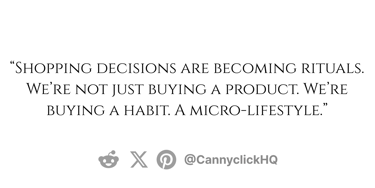From Reviews to Rituals: Why the New Amazon Shopper Trusts Vibes More Than Stars
This week on Cannyclick, we’re diving into a fascinating shift in how we shop online. Not with ratings, but with resonance. And to guide us through it, we’re excited to feature a new perspective from our contributor, Eli Han. His first piece explores why today’s Amazon shopper is choosing mood over metrics. Let’s get into it.
MODERN HOME TRENDS
Eli Han
8/14/20255 min read


The Feeling That Starts It All
The other day, I bought a mini bookshelf I didn’t know I needed. Not because it had 5,000 five-star reviews... but because someone on TikTok styled it next to their diffuser, a soft yellow lamp, and a worn-out copy of "The Artist’s Way." It looked... right. Like a little altar for calm. I didn’t read the specs. I didn’t even read the reviews. I just clicked.
And I’m not the only one.
In 2025, Amazon shoppers, especially those of us balancing work and life in quiet corners of our home, aren’t looking for the "best-rated." We’re looking for something that feels right. Not just efficient, but emotionally aligned. Not just reviewed... but relatable. It's less about checking a box and more about checking in with yourself.
What Sparked This Shift?
Over the last few years, the way we shop online has changed. A lot. The once-standard behavior of scrolling through dozens of product reviews has started to feel... exhausting. And more importantly, unnecessary. With so much content flying at us from every angle, we’ve developed new filters. Ones that aren't logical, but emotional.
According to a recent report from GWI (Global Web Index), emotional connection now drives over 60% of consumer purchase decisions online, even in practical categories like home goods and tech accessories. The same study shows a decline in reliance on user star ratings as shoppers lean more into visual content and peer mood boarding.
Part of this shift? The rise of short-form content. TikTok. Instagram Reels. Pinterest boards. Our feeds are filled with cozy spaces, aesthetic rituals, and "that girl" setups. These snippets of lifestyle, even when curated, offer something traditional reviews can’t... a feeling. And the products that show up there... stick. Because they’re not just presented. They’re performed.


1. The Age of Vibe Validation
In 2018, we filtered our buying decisions through Amazon’s top-rated section. In 2025? We ask: "Does this match the life I’m trying to create?"
The validation isn’t in the star count anymore. It’s in the emotional resonance. That lamp that glows like morning sun. The kettle that hums like a background score. The desk mat that makes you want to write. These aren’t product specs. They’re sensory cues that whisper, "You belong here."
Amazon’s image gallery and customer uploads now matter more than any written review. Seeing an item in a real-life setup, especially one that mirrors our dream environment, does more convincing than 100 paragraphs of text ever could. It's storytelling with stuff. And it's how our brains, tired from decision fatigue, want to engage.
2. Influencer Reviews > Customer Reviews
There’s been a steady movement toward trusting creators over crowds. When an influencer like @cozysetup posts a 15-second clip of her desk corner, featuring a product with ambiance, it creates a sense of trust. Not in the product itself... but in the feeling it promises.
Amazon knows this. That’s why they’ve expanded their Creator Hub tools, launched Inspire (a short-form shoppable feed), and made influencer storefronts easier to navigate. They’re following the emotion.
Even as busy professionals, especially busy professionals, we crave shortcuts that also feel... personal. We trust people who remind us of us. Or maybe people we want to be. Someone calm. Someone in control. Someone who’s figured out how to make their space feel like it matters.
3. Reviews Feel Tired. Rituals Feel True.
Let’s be honest. Written reviews are starting to sound the same. “Great quality.” “Fast shipping.” “Met expectations.” Useful? Maybe. Memorable? Not really.
But rituals are different. When someone says, "Every morning, I light this candle before I open my laptop, and it tells my brain we’re starting," that stays with you. That tiny act becomes a part of your imagined routine. You don’t just want the product. You want the mood that wraps around it.
Shopping decisions are becoming rituals. We’re not just buying a product. We’re buying a habit. A micro-lifestyle. Amazon is adjusting to that. Their A+ content pages now focus more on lifestyle photography, use-case visuals, and mood-led descriptions. They're not selling an item. They're showing a moment.
It’s no longer just a platform for transactions. It’s becoming a kind of companion. A mood board in motion. A place that doesn’t just sell you things, but offers you a version of yourself you’ve been trying to find.
And this shift isn’t done yet.
4. The New Metrics of Trust
It’s still about trust. But not the same kind.
Does this product make me feel ready?
Does it match my pace?
Can I picture it in my space, beside my coffee and half-finished to-do list?
Will it help me feel more myself, not just more efficient?
Shoppers, especially women in high-performance roles, are optimizing their environments emotionally. It’s not about what works. It’s about what supports. It’s about the whisper of calm in a noisy day. The way a tool or object can say, “I see you.”
Instead of rational proof, we’re chasing resonance. Instead of digging for star ratings, we’re scrolling for softness. Instead of comparison charts, we’re leaning into comfort cues.
5. Amazon's Emotional Efficiency
That’s why we’re seeing products like ergonomic footrests, silent desk fans, or low-glow desk lamps topping Amazon’s bestseller charts. Not because they have the most technical specs. But because they help shape how we feel while working. Because they anchor us, in place, in mood, in presence.
And Amazon makes it simple. The browsing is intuitive. The delivery is fast. But most importantly? The purchase process asks very little of us.
Emotional efficiency. That’s the new Prime feature. And we don’t even need to name it. We feel it.
Conclusion: What This Means for the Thoughtful Shopper
We’re entering a new era of online shopping. One where the emotional impression, the vibe, outweighs the bullet-point benefits.
For shoppers who’ve built a career on making smart, clear-headed decisions... this might feel like a curveball. But maybe, just maybe, it’s a shift toward softer intelligence.
Shopping isn’t just about solving a problem anymore. It’s about supporting a feeling. A rhythm. A ritual. It's about crafting a space that supports not just productivity... but peace.
So next time you find yourself buying something because it looks... just right, trust that instinct.
It’s not impulsive. It’s intuitive. And maybe it’s exactly what you needed.


References
GWI. "Connecting the Dots 2024." https://www.gwi.com/reports/connecting-the-dots-2024
Amazon Newsroom. "Introducing Inspire, a New Shopping Feed." https://www.aboutamazon.com/news/retail/amazon-inspire-shopping-feed
